 |
| http://www.flickr.com/ Photo by thekitchendesigner.org |
You may be trying to switch to a diet of natural, whole foods, but how do you transform your kitchen to help move you toward your goals? What do you do with those thirteen boxes of mac and cheese, 7 bottles of ketchup, and 4 cases of Coke you already bought because you were stocking up? Where do you start?
Get rid of the bad. In the perfect world, you would just wheel a dumpster into your kitchen and toss everything in, but most people’s budgets can’t handle a total restocking all at once. Even if you did have enough money to do that, you might not even know what you want to buy instead and would be left with nothing but empty cupboards.
While you're trying to decide whether or not to take the plunge into natural foods, or attempting to figure out just what the heck you're actually allowed to eat on an eating plan like this, finish up what's already in your kitchen and don't buy any more!
We had about a 2 week window between deciding to start Maximized Living and actually doing it. During those two weeks, I tried to buy as little as possible at the grocery store. We ate up everything we could from our pantry, cupboards, refrigerator and freezer. When something was gone, we ate something else instead of replacing it. (And yes, we had some very weird meals during that time, especially toward the end!)
We still didn’t completely eat everything. I’d been a big “stocker upper” and had a lot of boxes of Hamburger Helper and other pasta mixes that we just couldn’t finish. I gave food away to people who wanted it. I donated some, and yes, I did throw some away.
Do what you must to get rid of the bad foods, but don't leave them in your cupboards. If you do, you will eat them, especially during the first couple of weeks when you're having intense cravings.
Do some research. The perfect time to do this is while you’re cleaning out/finishing up the bad food in your house. Read books like Body by God, or Maximized Living Nutrition Plans, or check out the Maximized Living Blog. Collect some recipes you want to use. Try websites like Simply Sugar and Gluten Free, 100 Days of Real Food, and Maximized Living Recipes. Write down some of the “new” ingredients you want to buy and browse through your regular grocery store(s) to compare prices and check out their healthier inventory. Take some time to really understand what you want to buy and eat so you don’t waste money when you start buying more natural food.
Plan a menu. When you do start your new eating plan, don't get overwhelmed by choosing too many new recipes, which will result in gigantic shopping lists, oversized grocery bills, and hours in the kitchen. Just choose a couple of new recipes to try each week, and then plan some other meals that use similar ingredients so you’re not having to buy so many different things all at once. (Hint: Think simple, like roasted chicken with fresh or frozen vegetables.)Some of the better-for-you ingredients can cost a lot more, but they may also last a lot longer, so buy only what you can afford and slowly build up your pantry.
Replace slowly. When our family first cut out refined sugar and flour, our pantry looked almost bare. It was really kind of scary to open the door and find baggies, nuts and seeds, and some dried fruit. The cupboards didn’t look much different. I wasn’t sure what ingredients we would need, and so I didn’t buy very much, sticking with general staples like frozen vegetables and chicken, neither of which was stored in the panty. Over time, however, as I found more recipes I liked and discovered which ingredients we could have, I started finding sales again and stocked up on new, better foods. The cupboards and pantry are once again full of food, but this time, it’s much better for us!
No comments:
Post a Comment